I have often talked about our family’s gluten sensitivities/allergies/celiac disease and have shared gluten-free recipes with you, but I thought I would put all of my tips I have gathered over the years in one place for those of you who are trying to navigate a gluten-free lifestyle and feel overwhelmed. Luckily, this is a great time to be gluten-free since there are so many products on the market. Some are delicious and some, not so much. There are also many cookbooks using many different types of flours—which is awesome if you have the time and enjoy making your own gluten-free flour mixes, but this can be difficult and prohibitive in our busy lives.
First a little background. Although celiac is found in less than 1% of the population, it is believed now that at least 6% have gluten or wheat sensitivities. And many researchers believe this number to be way too conservative since many people voluntarily have gone off gluten without getting a diagnosis that can be used in the statistics. Even at 6%, that means there are at least 20,000,000 Americans who suffer from some sort of wheat or gluten allergy. Symptoms range from stomach problems, fatigue, brain fog, skin disorders, anxiety, headaches, joint pain, and numbness in extremities.
Why are people suddenly having so many problems with gluten? It turns out, the wheat we eat is very different from that which was cultivated long ago. It is believed that the huge rise in gluten sensitivities comes from unintended consequences of the cultivation of “dwarf wheat” by agronomist Norman Borlaug in the 1950’s and 1960’s. This wheat has larger seed heads giving a higher yield of wheat and was credited for saving over a billion people from starvation, for which Borlaug received a Nobel Peace Prize. Bigger wheat, however, created more gluten. Additionally, modern methods of refining flour releases more gluten than does older, traditional methods, increasing the amount of gluten consumed. More gluten = more people with gluten allergies. (Barley and rye are also sources of gluten and must be eliminated in a gluten-free diet.)
And now…here's a list of things I've learned while trying to navigate a gluten-free lifestyle:
1. Read Labels. The first and most important thing to remember when embarking on a gluten-free diet is that you MUST read every label. For a celiac, this is imperative and food also needs to be prepared in a gluten free facility. (For gluten allergies, you might get away with eating gluten free food prepared around gluten.) Gluten is hidden in many foods under many tricky names. Go here for a complete list of ingredients to watch out for. Luckily, allergens are now listed on most packaged foods so this step is easier than it used to be.
2. Bread. Larry and I have found that gluten free breads are best when toasted. You can even toast the bread for a sack lunch and it won’t be soggy by noon. If you live near gluten free bakeries, you might find a local bakery that makes bread to your liking. We have several … Johann’s Bakery (their baguettes are AMAZING) and 2Good2B are two that I like and you can order from both online. My favorite bread, however is the gluten free Prairie bread from Whole Foods. It is amazing. Unfortunately, Whole Foods doesn’t have an online store for those of you who don’t have a Whole Foods in your area. Luckily, Udi’s whole grain gluten free bread is good and can be found at all the large grocery stores. And now Costco is carrying The Essential Baking Company gluten free bread in twelve states with more coming soon. I haven’t tried it yet but I hear it is wonderful.
3. Pasta. I have tried many brands of pasta and my favorite BY FAR is Bionaturae brand. It cooks like traditional pasta to an al dente texture and is delicious. Nobody ever knows the difference when I serve it.
4. Piecrust. There are several great gluten-free crust recipes out there, but Whole Foods brand gluten free frozen piecrusts are absolutely amazing. I keep a couple in my freezer to make quiche or pies with. They are just as good as home made.
5. Flour. For best results in baking gluten free, the flour must be a mixture of different types of flours with the addition of guar or xanthan gum to replace the elasticity of wheat gluten. David likes to make his own mixes using a variety of flours, but I find this too much fuss. My favorite pre-made flour blends are made by Pamela’s as I have often mentioned here. Pamela’s Artisan Flour Blend works great as a wheat flour substitute in most recipes. I buy the 4 lb package because I bake quite a bit and it is much more economical, but it more readily comes in a 24 oz package. I use this flour for thickening sauces, too, but use less than traditional flour for making gravies. Pamela’s makes two other flour blends…their Bread Mix (great for bread, bagels, pizza dough, and gingerbread) and their Baking and Pancake mix (great for pancakes, sweet loafs, biscuits, muffins, and scones), both also available in the 4 lb size. You can go to their website to find out which flour is best for which recipes or experiment around on your own. Remember that there is added sugar in the bread mix and dried milk in the pancake mix. The website also has many fabulous recipes for you to try using their products.
6. Pancakes. For pancakes, use Pamela’s Baking and Pancake mix. (I use milk instead of water.) These pancakes are even better than traditional pancakes.
7. Cookies. If you want ready-made, this is a little harder, but then I am not a huge fan of most packaged cookies. The problem is that you really feel the grainier texture in most gluten free cookies. Again, Whole Foods makes amazing gluten free cookies and their peanut butter cookies are as good as homemade. I like Pamela’s dark chocolate chunk cookies, too, but they are hard to find. I find it best to make your own cookies, substituting gluten-free or almond flour for the flour in the recipes.
8. Crackers. My favorites are Mary’s Gone Crackers as they are really nutritious, have a hearty flavor and hold up well in dips. But some people think they are too hearty. Crunchmaster multi-seed and multi-grain crackers are delicious and a great value (you can find them at Costco, too!) There are a lot of rice crackers out there, too. Look for the ones made with brown rice flour for more nutrition. I prefer the Blue Diamond Nut Thins, though. Yehuda makes a terrific gluten free matzo if you like a plain cracker. Glutino brand Table Crackers work great for cheese but are a bit grainy in texture on their own.
9. Chocolate cake. I am putting this in it’s own category because Pamela’s chocolate cake and dark chocolate frosting make the BEST chocolate cake. It is so good that Archer and Fable, who are not gluten free, ask me to make it for everyone’s birthdays.
10. Corn bread. I am putting this in its own category, too, because this is the one case where I don’t like Pamela’s but prefer Bob’s Red Mill cornbread mix. It turns out kind of like cake and is amazing the next day toasted for breakfast. Of course if you have a favorite cornbread recipe, you can substitute gluten free flour for the flour.
11. Bulgur wheat or couscous. If you like using bulgur wheat or couscous, use quinoa, instead. It works perfectly as a substitute in tabouleh or in any Middle Eastern couscous dishes.
12. Pizza. Many pizza parlors now carry gluten-free pizza but they are not always prepared in a gluten-free environment, so if you have celiac disease, ask the restaurant
how they are prepared and cooked. Also, there are many gluten-free frozen pizzas available. You can also make your own gluten-free pizza dough, either from scratch or with a mix. Bob’s Red Mill makes a great one as does Pamela's.
Wendy’s Beyond Delicious Pesto, Artichoke,
Sun Dried Tomatoes and Arugula Gluten Free Pizza this is the longest name for a recipe ever
1 package Bob’s Red Mill or
Pamela’s gluten free pizza mix
1 recipe nasturtium pesto made with half the normal amount of oil (or your favorite pesto)
8 oz FRESH mozzarella (mozzarella
fresca)
3-4 oz good quality ricotta cheese
1 can quartered artichoke hearts,
drained on paper towels
A handful of sun-dried tomatoes
Several handfuls of arugula
1 16 inch pizza pan or stone or 2
12 inch pans
Pre-bake the pizza dough, as directed, for 9 minutes.
Spread the dough with the pesto. Evenly distribute the cheeses on top of the pesto and then add the artichoke hearts and sun dried tomatoes.
Bake at 425 for 15 minutes. Sprinkle arugula all over pizza and bake for two more minutes. Cut into slices using kitchen scissors or a pizza roller.
Enjoy!
Any gluten-free tips? Favorite pizza toppings? I’d love to hear from you!
Love,
WWW

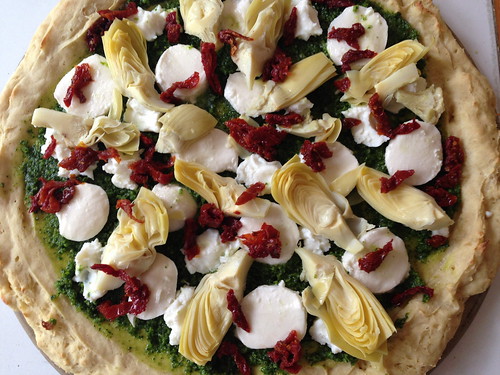
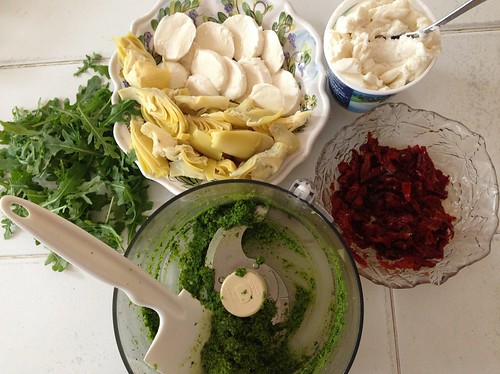
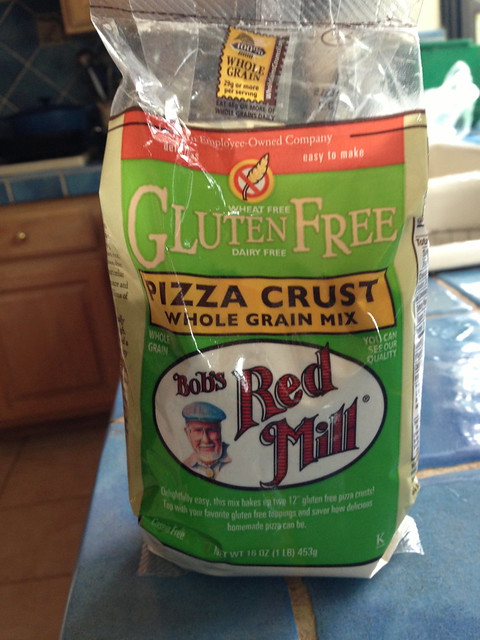
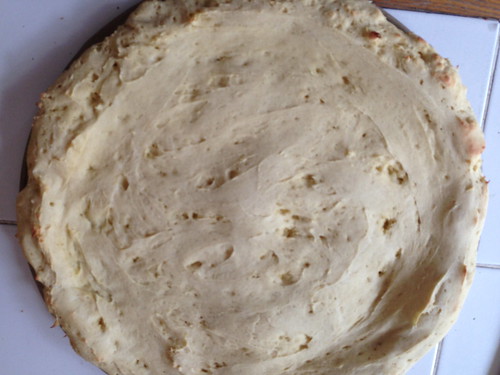
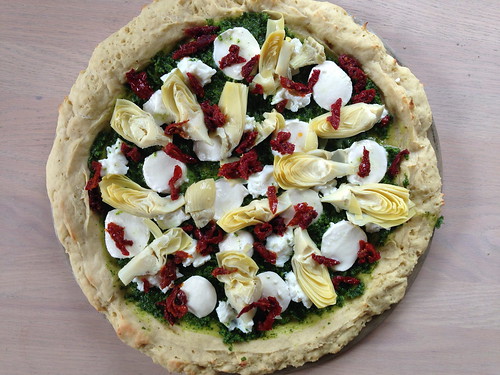
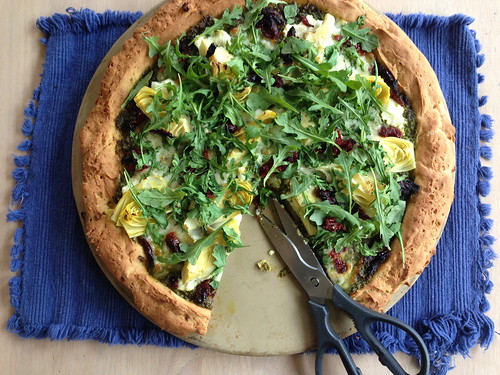


0 comments:
Post a Comment